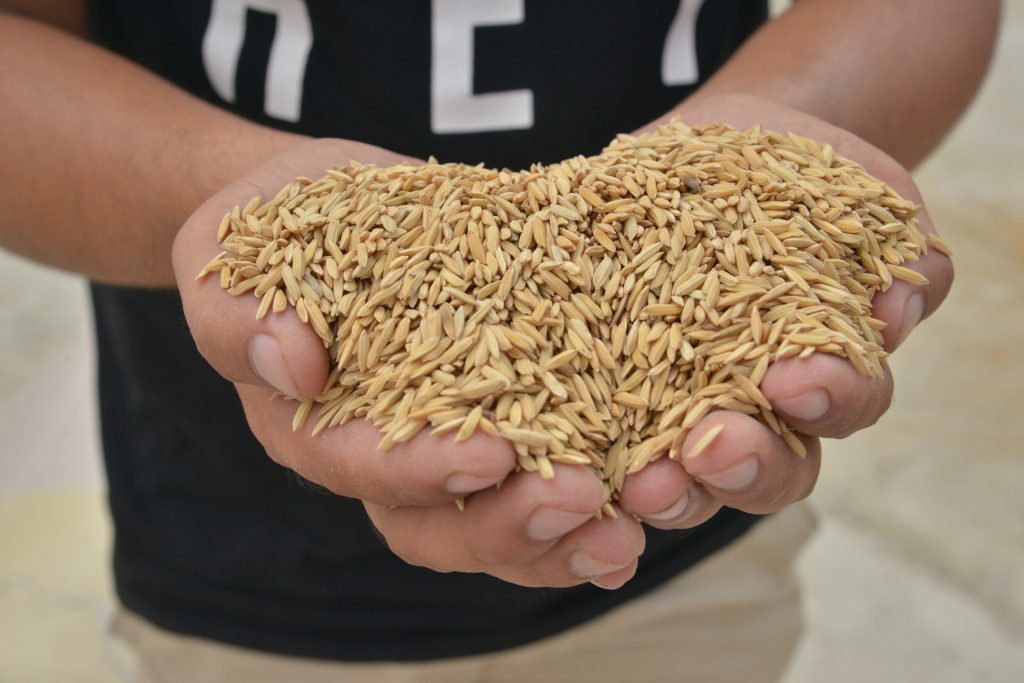
Bountiful harvest starts with the right seeds. This is why farmers like Ricardo Martinez, 59, of Bacolor, Pampanga is sometimes overwhelmed with the choices that he has to take before planting time. For which is just the fitting variety to plant among the more than 300 rice varieties approved by the National Seed Industry Council (then Philippine Seed Board) since 1977?
Choose right
With almost 30 years of farming experience, Mang Ricardo has been through the ups and downs of farming. He recalled harvesting nothing due to drought and floods. Sometimes, pests and diseases also infest his ricefields. Let’s sneak a peek at what he and experts have to say in choosing the right variety:
1.Resistance to pest and diseases
“There are varieties that are resistant to certain pests or diseases and there are some that are not. It is important to choose which is fitting against those that occur in the locality,” Mang Ricardo said.
The Rice Knowledge Bank of International Rice Research Institute (IRRI) published that on the average, pests and diseases can reduce yield by 37% annually. To avoid this, the first line of defense is choosing resistant rice varieties.
For instance, Mestizo 1 (PSB Rc 72H) and NSIC Rc 222 have intermediate reaction to the tungro virus. Mestiso 20 (Rc 204H), Rc 216, Rc 434, and Rc 472 are susceptible to the disease but are moderately resistant to the green leaf hopper (GLH), the virus vector. NSIC Rc 430, Rc 424, Rc 420, and Rc 418 are also resistant to GLH and has intermediate reaction to stemborer and brown plant hopper.
2. Tolerance to water submergence/drought
“It is important for us farmers to look at possible weather patterns. For this wet season, we should plant varieties that can tolerate water stress,” the farmer suggested.
Tolerance to water submergence is crucial particularly in areas where flooding occurs, and the water does not subside immediately. In these areas, farmers may opt to plant NSIC Rc 194 (Submarino 1), a variety that can survive water submergence up to 14 days at vegetative phase. PSB Rc 68 also tolerates water submergence.
While the wet season is coming, the ongoing El Niño still affects some provinces in the country. In areas where water is scarce or irrigation is delayed, farmers may choose drought-tolerant varieties: PSB Rc 10, Rc 14, NSIC Rc 192, and Rc 222.
3. Consider the soil characteristics
Some rice varieties can grow even in adverse soil conditions such as acidic and saline soils. PSB Rc 1 is suited for acidic soils while PSB Rc 48, Rc 50, NSIC Rc 106, Rc 190, Rc 392, and Rc 462 show some tolerance to salinity.
“Know the soil-type and ask for the appropriate variety for that,” Mang Ricardo said.
4. Right environment
Farmers also need to consider the rice ecosystem: irrigated, rainfed, upland, saline-prone, or cool-elevated. Joel Pascual of PhiRice’s Technology Management and Services Division said varieties are adapted to specific environments.
He explained, farmers often prefer new varieties thinking that they yield better, however, rice varieties are location-specific and are released not just based on yield but also other characteristics, such as resistance to pest and diseases, tolerance to drought or submergence, and grain quality.
“A variety may still produce in a different environment but adapted varieties can perform better as they were released for that purpose” the expert said.
For irrigated environments, farmers may plant the Tubigan varieties, such as NSIC Rc 160, Rc 222, Rc 216, Rc 300, Rc 402, Rc 204H (M20) and PSB Rc 72H (M1); Sahod Ulan varieties, such as NSIC Rc 272, Rc 276, Rc 280, Rc 416, Rc 472 for rainfed areas; and NSIC Rc 9, Rc 11, and Rc 23 for upland environments.
5. Maturity
Based on the Pinoy Rice Knowledge Bank of PhilRice, early maturing varieties are less prone to pests and diseases. These varieties mature in less than 110 days making them less exposed to typhoon that causes lodging. These varieties include PSB Rc 10, NSIC Rc 152, and Rc 130. Meanwhile, late-maturing varieties, which matures in more than 126 days, have higher yield potential owing to better vegetative growth.
6. Resistance to lodging.
Studies show that lodging lowers grain quality and makes the crop difficult to harvest. Factors, such as plant height, light intensity, the method of crop establishment, wind velocity and rain, stem thickness, and root structure affect lodging. Resistant varieties include PSB Rc 2, Rc 30, Rc 34, and Rc 74.




